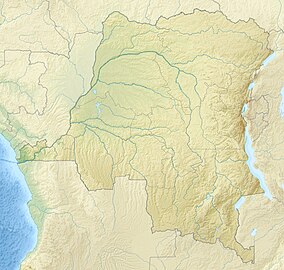Okapi Wildlife Reserve
| Okapi Wildlife Reserve | |
|---|---|
 Epulu River in the Okapi Wildlife Reserve | |
| Location | Democratic Republic of the Congo |
| Nearest city | Isiro |
| Coordinates | 02°00′00″N 28°30′00″E / 2.00000°N 28.50000°E |
| Area | 13,726.25 km2 (5,299.73 sq mi)[1] |
| Established | 1992[2] |
| Governing body | l'Institut Congolais pour la Conservation de la Nature (ICCN) |
| Criteria | Natural: x |
| Reference | 718 |
| Inscription | 1996 (20th Session) |
| Endangered | 1997 - |
The Okapi Wildlife Reserve (
Ecology
The wildlife reserve makes up roughly one-fifth of the total area of the
Because of its relatively stable climate during the repeated
Other mammals identified within the reserve include the
The reserve has over 370 species of bird, and is one of the most important sites for bird conservation in mainland Africa.
The imposing
History
The Okapi Wildlife Reserve was created with the help of the
Conservation
The wildlife reserve the location of the Epulu Conservation and Research Center, on the Epulu River. This facility dates back to 1928 when the camp was founded by American anthropologist Patrick Putnam as a capture station, where wild okapis were captured and sent to American and European zoos. Until 2012 it still served that function, albeit with very different methodology, as the okapis remained in Congo. In 2012 a rebel attack left the center's captive okapis dead and it was decided to focus exclusively (at least as long as there were security concerns) on preserving the wild okapis in the reserve.[8] The center also carries out much important research and conservation work.
Gold mining
As of 2015 there was a gold artisanal mining camp at Muchacha within the reserve employing about 8,000 people. The mine was run by a loosely organized rebel faction, Mai-Mai Simba, who aimed to liberate the local population from the reserve's land use restrictions. The warden of the reserve, Colonel Lucien Gedeon Lokumu announced operation Safisha to clear the reserve of rebel forces and mining operations.[9]
A June 2021 report from the United Nations Group of Experts on the Democratic Republic of the Congo raised concerns about the presence of semi-industrialized dredging operations 12 kilometers south of Bandegaido, within the Okapi Wildlife reserve. Mining took place within the Muchacha Ming Complex (MMC) which is covered by a permit from the official DRC Mining Cadastre, held by the Chinese businessman Kong Maohuai's MCC Resources. The company Kimia Mining Investment sarl was operating at the mine. Mining is illegal in the reserve, and FARDC troops were guarding the mining site, also in violation of Congolese law.[10]
Later that month, the Congolese authorities announced the seizure of 31 kg of gold (about $1.9 million worth) from this Muchaha mine.[11] As of 2022, non-governmental organizations such as the Council for Environmental Defense through Legality and Traceability (CODELT) and Alerte Congolaise pour l’Environnement et les Droits de l’Homme (ACEDH) blame mining operations for destroying pristine rainforest within the reserve.[12]
Rebel attacks

On 24 June 2012, the Epulu Conservation and Research Center was attacked, looted and burned by a group of
On 14 July 2017, there was an attack in the section of the reserve near Mambasa, likely by Mai-Mai rebels. Foreign journalists (two British and an American) and several local park rangers escaped unharmed, but five local reserve employees (four wardens and a tracker) were killed.[15][16] Several of the attackers were also killed.[16]
See also
- Centre National d'Appui au Développement et à la Participation populaire
- Corneille Ewango
- Okapi Conservation Project
References
- ^ INSTITUT CONGOLAIS POUR LA CONSERVATION DE LA NATURE. Okapi Archived 2005-01-18 at the Wayback Machine
- ^ Okapi Archived 1997-07-10 at the Wayback Machine
- ^ "21 World Heritage Sites you have probably never heard of". The Telegraph. Daily Telegraph. 4 February 2016.
- ^ a b c d e f g h i "Okapi Wildlife Refuge". UNESCO World Heritage Centre. United Nations Educational, Scientific, and Cultural Organization. Retrieved 13 June 2021.
- PMID 22096529.
- ^ "Okapi Wildlife Reserve". Guide for Africa. Retrieved 2011-10-25.
- ^ "Okapi Conservation Project". Wildlife Conservation Network.
- ^ a b c d Mongobay (9 September 2013).A year after devastating attack, security returns to the Okapi Wildlife Reserve (photos). Retrieved 16 July 2017.
- ^ Stokes, Elaisha (2015-02-23). "Saving Okapi in the Democratic Republic of Congo". Al Jazeera America. Retrieved 2022-10-29.
- ^ Group of Experts on the Democratic Republic of the Congo (2021-06-10). "S/2021/560". United Nations Security Council. Retrieved 2022-10-27.
- ^ Holland, Hereward (2021-06-22). "Congo seizes gold worth $1.9 million in Okapi wildlife reserve". Reuters. Retrieved 2022-10-28.
- ^ Kambale, Erikas Mwisi (2022-10-19). "Congolese NGOs decry mining in main refuge of 'Africa's unicorn'". Reuters. Retrieved 2022-10-28.
- ^ a b Okapi Conservation Project (28 June 2012).Okapi Conservation Project, Epulu Update – June 28, 2012 Archived September 4, 2012, at the Wayback Machine. Retrieved 15 September 2012
- ^ Okapi Conservation Project (4 August 2012).Okapi Conservation Project, Update – August 4, 2012 Archived December 22, 2013, at the Wayback Machine. Retrieved 15 September 2012
- ^ New York Times (16 July 2017).U.S. journalist found alive in Congo, 5 others are killed. Retrieved 16 July 2017.
- ^ a b France24 (16 July 2017).Kidnapped US journalist in DR Congo found safe, five wardens killed Archived 2017-07-16 at the Wayback Machine. Retrieved 16 July 2017.
Further reading
- Susan Lyndaker Lindsey; Mary Neel Green; Cynthia L. Bennett (1999). The Okapi. University of Texas Press. ISBN 0-292-74707-1


